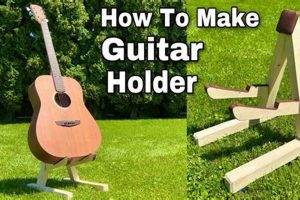A structure designed to support a guitar, crafted at home utilizing wooden materials and do-it-yourself methods, provides a customized and often cost-effective alternative to commercially available instrument supports. This encompasses a wide array of designs, from simple A-frame structures to more elaborate stands incorporating features like neck supports and accessory storage.
The construction of such a stand offers several advantages. Individuals can tailor the dimensions and aesthetic appearance to match their specific instrument and personal preferences. Moreover, utilizing reclaimed or readily available wood sources can significantly reduce material costs. Historically, resourceful musicians have often built their own equipment out of necessity or for personalized customization, making homemade instrument supports a continuation of this tradition.
Subsequent sections will explore various design options, construction techniques, and material considerations for building stable and aesthetically pleasing supports for stringed instruments. Further discussion will involve safety measures and finishing options for these handmade structures.
Construction Considerations for Wooden Guitar Supports
Effective design and execution are crucial when building a supporting structure for a guitar. The following tips address key areas to consider during the construction process.
Tip 1: Material Selection: Choose hardwoods, such as maple or oak, for primary structural components. These provide adequate strength and stability. Softwoods, like pine, may be suitable for non-load-bearing elements but should be avoided for critical supports.
Tip 2: Joint Integrity: Employ robust joinery techniques, such as mortise and tenon joints, dovetails, or pocket hole joinery, to ensure structural integrity. Simple butt joints secured with screws alone are generally insufficient for long-term stability.
Tip 3: Contact Point Padding: Apply protective padding to all areas where the guitar will make contact with the stand. Felt, cork, or specialized instrument padding can prevent scratches and other damage to the instrument’s finish.
Tip 4: Stability and Balance: Design the stand with a low center of gravity and a wide base to minimize the risk of tipping. Ensure the guitar’s weight is evenly distributed across the support structure.
Tip 5: Finish Application: Apply a durable finish to protect the wood from moisture and wear. Polyurethane or lacquer finishes provide excellent protection and enhance the wood’s aesthetic appeal. Ensure the finish is fully cured before placing the guitar on the stand to prevent chemical reactions with the instrument’s finish.
Tip 6: Neck Support Design: If incorporating a neck support, ensure it is properly contoured to cradle the neck without applying excessive pressure to any specific point. A gently curved support is generally preferable to a flat support.
Tip 7: Hardware Selection: Use high-quality hardware, such as screws and hinges, that are resistant to corrosion and wear. Avoid using hardware that is undersized or of questionable quality.
These construction considerations ensure that the handcrafted support provides a safe and reliable platform for the instrument while enhancing its presentation.
The final section will summarize safety precautions and maintenance advice for handmade guitar supports.
1. Stability
Stability, in the context of wooden, self-constructed guitar supports, directly relates to the stand’s ability to maintain equilibrium while holding the instrument. A stable support minimizes the risk of the guitar tipping over, thus preventing potential damage to the instrument. This necessitates careful consideration of design factors, material selection, and construction techniques. For example, a wide base increases the support’s footprint, making it less prone to toppling. Utilizing heavy, dense woods lowers the center of gravity, further enhancing stability. Inadequate stability, conversely, can lead to costly repairs or even irreparable harm to a valuable instrument.
The practical significance of understanding stability principles is evident in various design choices. A stand with a narrow base and a high center of gravity, even if aesthetically pleasing, presents a significant risk. The inclusion of angled legs, as opposed to straight vertical supports, enhances lateral stability. Weight distribution is also critical; uneven weight distribution can cause the stand to lean or wobble. Professional luthiers and experienced woodworkers often employ computer-aided design (CAD) software to simulate stress and stability, ensuring their designs meet rigorous safety standards prior to physical construction. This meticulous approach underscores the importance of proactive stability assessment.
In summary, stability is a non-negotiable requirement for a guitar supporting structure. Compromising stability for aesthetic appeal or ease of construction can have detrimental consequences. Proper planning, careful material selection, and meticulous construction techniques are essential to create a stable and reliable platform for the instrument. The challenges lie in balancing aesthetic preferences with functional requirements and understanding the underlying physics that govern structural stability. The long-term preservation of the instrument depends on a stable foundation.
2. Wood Selection
Wood selection directly impacts the structural integrity and aesthetic appeal of a guitar support constructed through do-it-yourself methods. The choice of wood affects the support’s weight-bearing capacity, resistance to warping, and overall durability. Hardwoods, such as maple, oak, and walnut, offer superior strength and stability compared to softwoods like pine or cedar. The use of an unsuitable wood type can result in a structurally unsound support, increasing the risk of instrument damage. For instance, a support built entirely from pine may buckle or break under the weight of a heavier guitar, while a hardwood construction is more likely to withstand the load and maintain its shape over time.
Aesthetically, wood selection influences the visual character of the guitar support. Different wood species exhibit distinct grain patterns and colors, allowing for customization to complement the instrument or the surrounding environment. A support constructed from cherry, for example, will possess a reddish hue and a smooth, fine grain, while oak offers a more pronounced grain pattern. Furthermore, the chosen wood’s workability affects the ease with which it can be shaped, joined, and finished. Some woods are more prone to splintering or cracking during the construction process, necessitating greater care and skill. The cost of different wood species also varies significantly, representing a practical consideration for the do-it-yourself builder. Reclaimed wood presents an environmentally conscious and often cost-effective alternative, though it may require additional preparation to ensure its suitability.
In summary, the informed selection of wood is a critical factor in the successful construction of a guitar support. Balancing structural requirements, aesthetic preferences, and budgetary constraints dictates the final material choice. Neglecting this aspect can compromise the support’s functionality and longevity. The challenges lie in understanding the properties of different wood species and their suitability for this specific application. The effective combination of material knowledge and construction skill is key to producing a safe, durable, and visually appealing guitar support.
3. Joint Strength
Joint strength represents a critical determinant in the structural integrity and longevity of guitar supports constructed through do-it-yourself methods. Inadequate joint strength can result in catastrophic failure of the support, potentially leading to damage to the instrument. The primary function of a guitar stand is to safely and reliably support the weight of the instrument; thus, the joints, which connect the various components of the stand, must be capable of withstanding significant stress. A poorly constructed joint, even with high-quality materials, weakens the overall structure and increases the risk of collapse. For example, a simple butt joint secured only with screws may appear adequate initially, but under sustained load or sudden impact, it is prone to failure. Conversely, a well-executed mortise and tenon joint, or a dovetail joint, distributes the load more effectively and provides significantly greater resistance to shear and tensile forces.
The practical implications of understanding joint strength are evident in the selection of appropriate joinery techniques for specific components of the guitar support. Areas bearing the greatest weight, such as the base supports and the neck cradle, require robust joints capable of withstanding constant stress. For these critical areas, techniques like mortise and tenon, dovetail, or reinforced miter joints are recommended. Less stressed areas, such as decorative elements, may utilize simpler joinery methods. The selection of appropriate adhesives also plays a critical role in joint strength. High-quality wood glues, applied properly, significantly enhance the bond between components. Proper clamping during the gluing process is essential to ensure adequate contact and optimal adhesion. Furthermore, the type of wood used in conjunction with the joinery technique affects overall strength. For instance, hardwoods generally provide better holding power for screws and adhesives compared to softwoods. The integration of metal fasteners, such as screws or bolts, can further reinforce critical joints, especially in areas subject to high stress or repeated movement.
In summary, the significance of joint strength in the construction of wooden guitar supports cannot be overstated. Weak or poorly executed joints compromise the structural integrity of the entire support and pose a significant risk to the instrument. Careful selection of appropriate joinery techniques, combined with the proper use of adhesives and, where necessary, reinforcing fasteners, is essential to create a safe, reliable, and durable support. Challenges lie in acquiring the necessary woodworking skills and understanding the mechanical principles that govern joint strength. Ultimately, the investment in time and effort to master these techniques is essential to ensure the long-term safety and stability of the guitar support, thereby protecting the valuable instrument it holds.
4. Padding
Padding is a crucial element in self-constructed wooden guitar supports due to its direct impact on the instrument’s physical protection. The rigid nature of wood, while providing structural support, poses a risk of scratching, denting, or otherwise damaging the guitar’s finish, particularly at points of contact. The absence of adequate padding introduces a direct cause-and-effect relationship: Hard wood surfaces in direct contact with the guitar result in cosmetic imperfections over time. Padding, typically composed of materials such as felt, cork, foam, or specialized instrument-grade materials, creates a buffer zone, absorbing pressure and preventing direct abrasion. The selection of padding material influences its effectiveness; denser materials offer greater protection against compression, while softer materials are more effective at preventing surface scratches. For instance, a stand constructed without padding on the neck cradle is likely to cause pressure marks or scratches on the guitar’s neck finish over repeated use.
The practical application of padding extends beyond simply covering contact surfaces. The thickness and density of the padding must be carefully considered in relation to the weight and finish of the guitar. Thinner padding may be suitable for instruments with robust finishes, while more delicate finishes necessitate thicker, higher-density padding to provide adequate protection. The method of affixing the padding to the wooden support is also important. Adhesives must be chosen carefully to avoid damaging the guitar’s finish should contact occur. Some adhesives may react with certain finishes, causing discoloration or softening of the lacquer. Mechanical fasteners, such as staples, can be used, but care must be taken to ensure the fasteners do not protrude and create new points of contact. Furthermore, the durability of the padding itself must be considered. Over time, padding can compress, tear, or degrade, reducing its effectiveness. Regular inspection and replacement of worn padding is essential to maintain adequate protection. A real-world example is where a well-intentioned builder using the wrong adhesive, inadvertently causes chemical damage, costing more to repair than buying a professional stand.
In summary, padding is an indispensable component of self-constructed wooden guitar supports, safeguarding the instrument from physical damage. Proper material selection, careful application, and regular maintenance are essential to ensure its continued effectiveness. The challenge lies in balancing cost-effectiveness with the level of protection required for a specific instrument. Neglecting the importance of padding can result in preventable cosmetic damage, ultimately diminishing the value and aesthetic appeal of the guitar. The implementation of thoughtful padding solutions is a proactive measure that preserves the instrument’s condition and longevity.
5. Finish
The finish applied to a guitar support constructed through do-it-yourself methods directly impacts its durability, aesthetic appeal, and, potentially, the safety of the supported instrument. The purpose of a finish extends beyond mere visual enhancement; it provides a protective barrier against moisture, scratches, and other environmental factors that can degrade the wood over time. An unfinished wooden support is susceptible to warping, cracking, and staining, which can compromise its structural integrity. Furthermore, raw wood can leach resins or oils that could interact negatively with the finish on the guitar itself. Therefore, the choice and application of a suitable finish are critical considerations in the construction process. For example, polyurethane provides a durable, water-resistant coating suitable for high-traffic areas, while lacquer offers a more traditional aesthetic with a smoother feel.
Practical application necessitates careful selection of finish type based on the intended environment and the builder’s skill level. Oil-based finishes penetrate the wood, offering good protection from within, but they require longer drying times. Water-based finishes are easier to clean up and release fewer volatile organic compounds (VOCs), but may not provide the same level of durability as oil-based alternatives. Spray application, whether with aerosol cans or professional equipment, yields a more even and consistent finish compared to brush application, but requires proper ventilation and safety precautions. Regardless of the chosen method, proper surface preparation is crucial. Sanding the wood to a smooth, uniform surface ensures optimal adhesion and a flawless final appearance. Multiple thin coats are generally preferable to a single thick coat, as they reduce the risk of runs and drips and allow for more even curing. A real-world example shows that a guitar stand made from pine and coated with water-based acrylic paint will need many layers of coat to have the protection and good looks compared to stand with hardwood, coated with oil-based paint in 2-3 layers.
In summary, the finish is an integral component of a guitar support, contributing significantly to its longevity, visual appeal, and protective capabilities. Selecting the appropriate finish and applying it correctly requires careful consideration of material properties, environmental factors, and the builder’s skill set. Neglecting the finish or applying it improperly can compromise the support’s structural integrity and potentially damage the instrument it is intended to protect. The challenge lies in balancing aesthetic preferences with practical considerations to achieve a durable, visually pleasing, and instrument-safe result. The integration of finish into planning and construction ensure a completed project that is safe for guitars and last for years.
Frequently Asked Questions
This section addresses common inquiries and concerns regarding the construction and use of guitar supports built from wood using do-it-yourself methods.
Question 1: What is the minimum recommended wood thickness for a guitar support’s legs?
The minimum recommended wood thickness for the legs of a guitar support is one inch (2.54 cm). This provides adequate structural stability to support the weight of most guitars. Thinner dimensions may compromise the support’s integrity.
Question 2: Is it necessary to use hardwood for all components of a guitar support?
While hardwood is recommended for load-bearing components such as the legs and the neck cradle, softwood may be suitable for non-structural elements. However, utilizing hardwood throughout the entire structure offers increased durability and longevity.
Question 3: What type of adhesive is best suited for joining wooden components of a guitar support?
Polyurethane or epoxy-based wood glues offer superior strength and water resistance compared to polyvinyl acetate (PVA) adhesives. These adhesives create a durable bond capable of withstanding the stresses placed on the joints.
Question 4: How can slippage of the guitar on the support be prevented?
Applying a non-slip material, such as rubber or silicone, to the contact points between the guitar and the support can prevent slippage. This material provides increased friction, ensuring the instrument remains securely in place.
Question 5: What is the recommended angle for the back support of a guitar stand?
An angle of approximately 10-15 degrees from the vertical is recommended for the back support. This angle provides optimal support for the guitar’s body while minimizing the risk of tipping.
Question 6: How frequently should the hardware on a wooden guitar stand be inspected?
The hardware, including screws and hinges, should be inspected at least every six months. Regular inspection allows for the identification and correction of any loose or damaged components, preventing potential structural failures.
These answers provide guidelines for addressing key considerations in constructing a safe and reliable wooden guitar support. Attention to these details ensures the instrument is protected.
The subsequent section will provide a summary of the key considerations and steps involved in the construction process.
Conclusion
The preceding analysis has detailed the various considerations involved in constructing a guitar support using wooden materials and do-it-yourself methods. Key areas explored include material selection, joint integrity, padding implementation, and finish application. Attention to these details is paramount to ensure the stability, durability, and protective qualities of the final product. The potential consequences of neglecting these factors range from cosmetic damage to catastrophic failure, underscoring the need for informed decision-making throughout the construction process.
The creation of a functional and aesthetically pleasing guitar support represents a worthwhile endeavor for the discerning musician or woodworking enthusiast. Continued vigilance in maintenance and adherence to established best practices will prolong the lifespan of the handcrafted support, providing a safe and secure platform for valuable instruments for years to come. The commitment to quality and precision in execution remains essential in the pursuit of this rewarding project.


![Build a DIY Vertical Bike Stand Today! [Plans & Guide] The DIY Hub: Creative Crafts, Repairs & Life Hacks Build a DIY Vertical Bike Stand Today! [Plans & Guide] | The DIY Hub: Creative Crafts, Repairs & Life Hacks](https://craftingdiycenter.com/wp-content/uploads/2025/07/th-3321-300x200.jpg)




